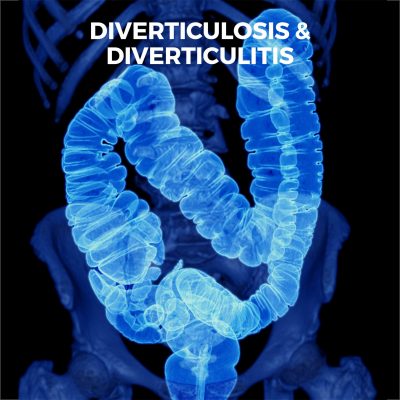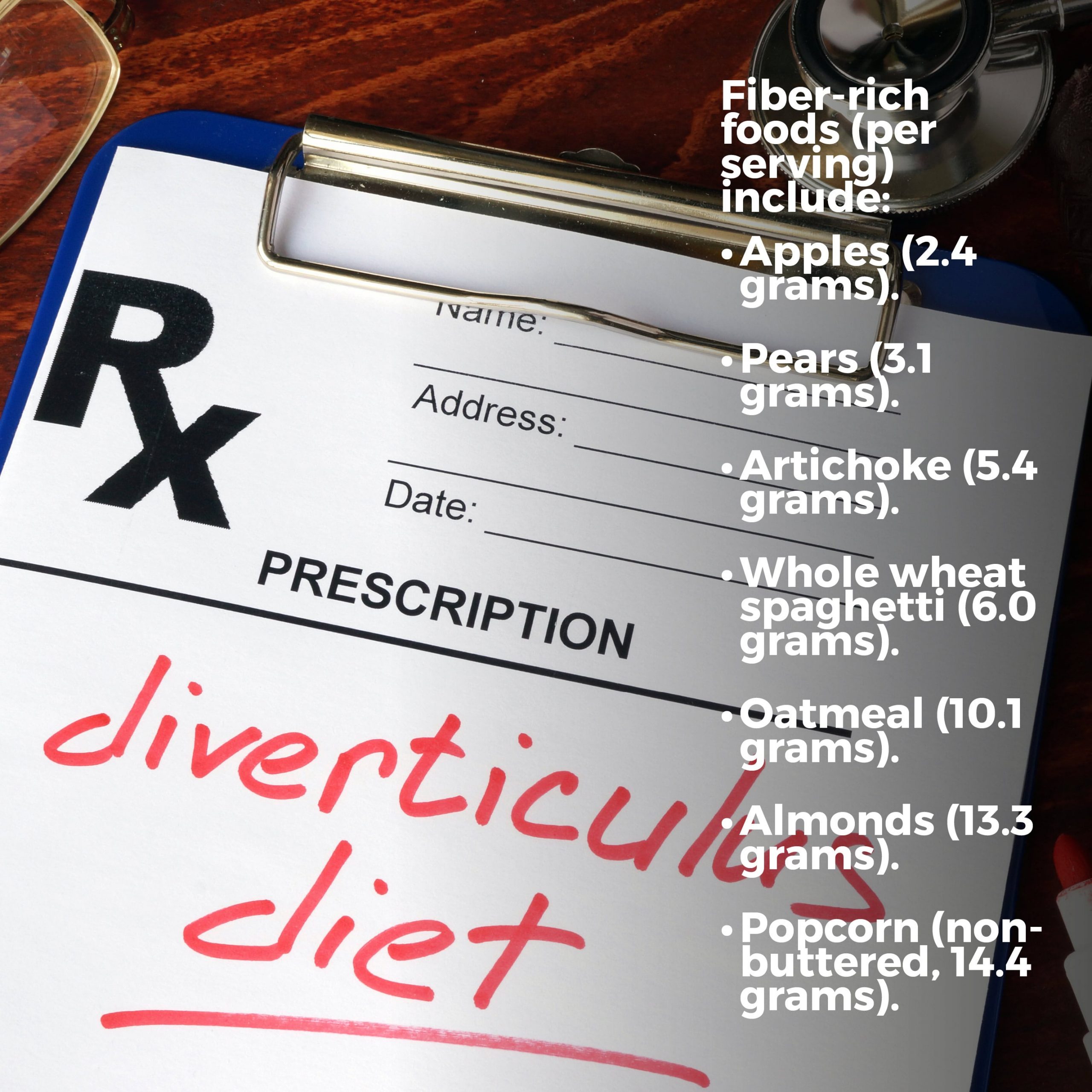
Diverticulosis and Diverticulitis
Diverticulosis and diverticulitis sound similar, but they are two different yet related conditions that affect the lining of the large intestine. Together, they are referred to as diverticular disease. They are characterized by diverticula, which are bulges that form on your intestine’s wall. Sometimes, these bulges are harmless. Other times, they may need to be addressed with surgery.
What are Diverticula?
Diverticula (die-vur-TICK-you-luh) are small, balloon-like sacs that protrude from the side of the lower large intestine (the descending or sigmoid colon). Diverticula are common and typically develop in 10% of people over the age of 40, and 50% of people over 60. Most people older than 80 have them. Some people only have one or two, while others have them throughout their colon.
Diverticula range in diameter from pea-sized to one inch. Occasionally, some grow up to six inches and are called giant diverticula.
Diverticula are like a bicycle tire filled with too much air. The excess pressure causes the tire’s inner tube to bulge at the rubber’s weakest point. When pressure increases inside the colon, bulges develop at its lining’s weakest point.
Most people who have diverticula aren’t troubled by them.
What is Diverticulosis?
Diverticulosis is the presence of diverticula in your intestine. At this stage, they don’t have symptoms or need treatment.
Diverticulosis can lead to a painful condition called diverticulitis.
What is Diverticulitis?
Diverticulitis (die-ver-TICK-you-lie-tiss) is a complication of diverticulosis. It occurs when the pouches become inflamed or infected. This is a more severe and potentially dangerous condition than diverticulosis.
What Causes Diverticulitis?
Diverticulitis can develop when you don’t eat enough fiber. Without adequate fiber, your body creates hard stools. The pressure from straining to force them through the colon causes its lining to squeeze the weakened outer layer, resulting in diverticula. Diverticula develop over many years of constipation and straining.
When you eat an adequate amount of fiber, it produces larger, softer stools that are easier to pass.

How Can I Get More Fiber in My Diet?
Most people only get a fraction of the fiber needed to maintain a healthy digestive tract. Fiber isn’t digested, so it bulks up your bowel movements. Women should aim for 20 to 25 grams of fiber a day, and men should eat 30 to 38 grams.
Fiber-rich foods (per serving) include:
- Apples (2.4 grams).
- Pears (3.1 grams).
- Artichoke (5.4 grams).
- Whole wheat spaghetti (6.0 grams).
- Oatmeal (10.1 grams).
- Almonds (13.3 grams).
- Popcorn (non-buttered, 14.4 grams).
If it’s difficult for you to get adequate fiber in your diet, you can also take a powdered, over-the-counter fiber supplement that’s mixed with water. Fiber supplements also come in capsules and chewable tablets. Supplements are an easy way to make sure you get dietary fiber.
What Are Other Risk Factors for Diverticulitis?
Besides a low-fiber diet, other factors can put you at risk for diverticulitis.
Not drinking enough fluids is a factor. Adequate fluid intake keeps your bowel movements soft and easy to pass. You can gauge whether you’re adequately hydrated by the color of your urine. If it’s light yellow or transparent, you’re drinking enough.
Not exercising enough puts you at risk. When you exercise at least 30 minutes a day, bowel movements travel more easily through your colon, decreasing the pressure inside. It doesn’t matter what type of exercise you do. Just get active.
Smoking is another risk factor.
Also, if you’re significantly overweight, you risk developing diverticulitis.
And finally, the use of nonsteroidal anti-inflammatory drugs (NSAIDs), naproxen sodium, and ibuprofen-type medications may put you at risk for diverticulitis.
What are the Symptoms of Diverticulitis?
It helps to familiarize yourself with diverticulitis symptoms so that you can seek help as soon as possible.
- Constant pain for several days.
- Nausea.
- Vomiting.
- Constipation.
- Fever.
- Bloody stools.
- Sudden, intense cramping or pain in your abdomen’s lower left side. This is the most common symptom of diverticulitis.
- Bloating.

How is Diverticulitis Diagnosed?
If you have any of the above symptoms, it’s important to see your doctor as soon as possible. Several tests can be used to diagnose diverticulitis.
Colonoscopy – During a colonoscopy, a thin tube with an attached light and video camera is inserted in your rectum and guided through your entire colon. The camera sends images to a monitor, where your doctor can analyze them for abnormalities. Tissue samples can also be taken during the procedure, if necessary.
Sigmoidoscopy – In this examination, a thin, lighted tube with a video camera is inserted in your rectum and passed through your sigmoid colon, where most diverticula originate.
CT Scan – CT scans (computed tomography) are a type of imaging that produces 3-D images. This allows your doctor to see your intestine in detail. It can reveal inflamed or infected diverticula.
Angiography – Angiographies are used to determine the source of rectal bleeding. During this procedure, a dye is injected into the arteries that supply the colon with blood to identify the bleeding’s origin.
Blood Test – An elevated white blood count can show that infection is present in your body.
Stool Sample – Your bowel movement is analyzed for parasites or bacteria that could be responsible for your symptoms.
Barium Enema – A barium enema is a type of X-ray exam, during which a high-contrast liquid called barium is inserted in the rectum, coating the wall of the large intestine. Barium’s contrast with your colon’s lining accentuates any abnormalities or inflammation.
How is Mild Diverticulitis Treated?
Mild diverticulitis is treated with oral antibiotics. Your doctor may also recommend over-the-counter pain medications and a liquid or low-fiber diet while you’re recovering. As you get better, you’ll be asked to eat soft foods and gradually return to your regular diet, being sure to include high-fiber food.
How is Severe Diverticulitis Treated?
Surgery may be necessary if you have any of these complications:
When you have a perforation, or tear, in your colon, feces and pus can seep into your abdominal cavity and create a dangerous infection called peritonitis. If your colon is perforated, you’ll need emergency surgery to deal with the infection and possible removal of the injured section of the colon.
Untreated diverticulitis may cause an abscess (a pocket of pus and bacteria). It must be drained with a catheter. If this is unsuccessful, you’ll need surgery. During the procedure, the abscess is cleansed, and the damaged part of the colon is removed.
Fistulas are complications of diverticulitis. A fistula is an abnormal passageway connecting organs that aren’t usually connected. A fistula in the intestine can connect to the vagina, uterus, bladder, or another part of the colon itself. Surgery is needed if a fistula doesn’t close on its own.
Your colon may develop strictures or narrowed sections from previous infections that have scarred it. This, as well as complete colon blockages, must be corrected surgically.
When a blood vessel near the diverticula bursts, surgery may be needed if other attempts to curtail the bleeding fail.
What Happens During Diverticulitis Surgery?
Two types of surgeries are typically used to treat diverticulitis. Surgery is only a last resort when all other options fail.
During colon resection, the damaged pouches are removed, and the remaining parts of the colon are reattached to the rectum. Patients pass bowel movements the typical way after this procedure.
Colon Resection with Colostomy is used in more severe instances of diverticulitis. It is a surgical rerouting of the healthy end of your intestine to an opening in the abdomen called a stoma.
After the procedure, waste passes into a bag attached to the stoma, instead of out of the rectum. Most colostomies are temporary and are only necessary until the colon heals, which is typically several months. At this point, the colostomy is reversed, and the healed part of the colon is reconnected to the rectum.
Contact Us
Get in touch with us today! The team of professionals at GastroMD looks forward to working with you. We are one of the leading gastroenterology practices in the Tampa Bay area. We perform a host of diagnostic procedures using state-of-the-art equipment in a friendly, comfortable, and inviting atmosphere where patient care is always a top priority!



